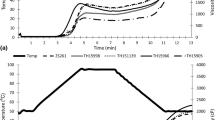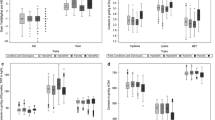Abstract
A great deal of genetic variability and breeding efforts have yielded a number of specialty maize types. Little is known about how the off-target traits in specialty maize kernel have changed and how they compare to those of standard maize genotypes. In this study, we compared the normal (NORMAL), high-oil (HOM) and high-protein maize (HPM) genotypes in terms of oil, protein, fatty acids and some mineral components. We also investigated the relationships among the evaluated traits in different kernel types. We detected a significant variation among the maize types for all of the investigated traits. Specialty maize genotypes had a superior performance for the traits they were specifically bred for, as well as kernel mineral content over the normal genotypes. HOM and HPM had similar values in terms of their fatty acid composition. However, they were different from the standard genotypes, with higher oleic and lower linolenic acid levels, which indicates that the specialty maize genotypes possess a better oil quality. Correlation analysis revealed that only three pairs of correlations out of 46 values had the same sign and a similar level of significance in different types. Such similarities or differences in correlation values for different types should be taken into account in the efforts for developing high quality maize genotypes.



Similar content being viewed by others
References
Hellin J, Dixon J, Higman S, Keleman A (2011) High-value agricultural products and poverty reduction: smallholder farmer access to maize markets. J Crop Improvement 25:371–391
Ram RV, Seshu G, Farzana J, Seshagiri RA (2012) Speciality corn types with reference to quality protein Maize (Zea mays L.)-A review. Int J Agric Environ Biotechnol 5:393–400
Lambert RJ (2001) High-oil corn hybrids. In: Hallauer A (ed) Specialty corns, vol 2. CRC Press, Boca Raton, pp 123–145
Watson SA (2003) Description, development, structure and composition of the corn kernel. In: White PJ, Johnson LA (eds) Corn: chemistry and technology. Am Assn Cereal Chemists Inc St. Paul, MN, pp 69–106
Langade DM, Shahi JP, Agrawal VK, Sharma A (2013) Maize as emerging source of oil in India: an overview. Maydica 58:224–230
Hopkins CG (1899) Improvement in the chemical composition of the corn kernel. University of Illinois Agricultural Experiment Station 55:205–240
Misevic D, Alexander DE (1989) Twenty-four cycles of phenotypic recurrent selection for percent oil in maize: I. Per se and test-cross performance. Crop Sci 29:320–324
Song TM, Chen SJ (2004) Long term selection for oil concentration in five maize populations. Maydica 49:9–14
Boyat A, Derieux M, Kaan F, Rautou S (1980) Maize breeding for improvement of kernel protein content using Illinois High Protein population. In: Pollmer WG, Phipps RH (eds) Improvement of quality traits of maize for grain and silage use. Martinus Nijhoff, The Hague
Chander S, Meng Y, Zhang Y, Yan J, Li J (2008) Comparison of nutritional traits variability in selected eighty-seven inbreds from Chinese maize (Zea mays L.) germplasm. J Agric Food Chem 56:6506–6511
Dunlap FG, White PJ, Pollak LM, Brummd TJ (1995) Fatty acid composition of oil from adapted, elite corn breeding materials. AOCS 72:981–987
Egesel CÖ, Kahrıman F, Gül MK (2011) Genotypic discrimination of maize inbreds for kernel quality traits and fatty acid composition by a multivariate graphical technique. ACTA Scientiarum Agronomy 33:613–620
Menkir A (2008) Genetic variation for grain mineral content in tropical-adapted maize inbred lines. Food Chem 110:454–464
Sanjeev P, Chaudhary DP, Sreevastava P, Saha S, Rajenderan A, Sekhar JC, Chikkappa GK (2014) Comparison of fatty acid profile of specialty maize to normal maize. J Am Oil Chem Soc 91:1001–1005
NMILL (1998) Nordic-Committee of Food Analysis. No:161
Anonymous (2007) TS EN ISO 734-1 Oil seed residues—determination of oil content—part 1: Extraction method with hexane (or light petroleum)
AOAC (2002) Protein (crude) in animal feed, combustion method. Method 990.03. Official Methods of Analysis of AOAC International. 18th edition. AOAC International, Arlington, VA, USA
David F, Sandra P, Wylie PL (2002) Improving the analysis fatty acid methyl ester using retention time locked methods and retention time databases. Agilent application note, Publication 5988-5871EN1, Printed in USA
Institute SAS (1999) SAS V8 User manual. Cary, NC
Oikeh SO, Menkir A, Dixon BM, Welch RM, Glahn RP (2003) Genotypic differences in concentration and bioavailabilty of kernel-iron in tropical maize varieties grown under field conditions. J Plant Nutr 26:2307–2319
Wu B, Andersch F, Weschke W, Weber H, Becker JS (2013) Diverse accumulation and distribution of nutrient elements in developing wheat grain studied by laser ablation inductively coupled plasma mass spectrometry imaging. Metallomics 5-1276-1284
Earle FR, Curtis JJ, Hubbard JE (1946) Composition of the component parts of the corn kernel. Cereal Chem 23:504–511
Motto M, Hartings H, Frcasetti M, Consonni G (2011) Grain quality-related traits in maize: gene identification and exploitation. Maydica 56:291–314
Raboy V, Below FE, Dickinson DE (1989) Alteration of maize kernel phytic acid levels by recurrent selection for protein and oil. J Hered 80(4):311–315
Uribelarrea M, Moose SP, Below FE (2007) Divergent selection for grain protein affects nitrogen use in maize hybrids. Field Crops Res 100:82–90
Dudley JW (2007) From means to QTL: the Illinois long-term selection experiment as a case study in quantitative genetics. Crop Sci 47:20–31
Dudley JW, Lambert RJ (2003) 100 generations of selection for oil and protein in corn. Plant Breed Rev 24:79–110
Liu Z, Yang X, Fu Y, Zhang Y, Yan J, Song T, Rocheford T, Li J (2009) Proteomic analysis of early germs with high-oil and normal inbred lines in maize. Mol Biol Rep 36:813–821
Dwivedi SL, Nigam SN, Prasad MVR (1998) Induced genetic variation for seed quality traits in groundnut. International Arachis Newsletter 18:44–46
Balconi C, Hartings H, Lauria M, Pirona R, Rossi V, Motto M (2007) Gene discovery to improve maize grain quality traits. Maydica 52:357–373
Shen N, Duvick S, White P, Pollak L (1999) Oxidative stability and AromaScan analyses of corn oils with altered fatty acid content. J Amer Oil Chem Soc 76:1425–1429
Earle FR (1977) Protein and oil in corn: variation by crop years 1907 to 1972. Cereal Chem 50:70–79
Piper EL, Boote KJ (1999) Temperature and cultivar effects on soybean seed oil and protein concentrations. JAOCS 76:1233–1241
Sweley JC, Rose DJ, Jackson DS (2012) Hybrid and environment effects on popcorn kernel physiochemical properties and their relationship to microwave popping performance. Faculty Publications in Food Science and Technology. Paper 115. Page: 188–194
Prasanna BM, Mazumdar S, Chakraborti M, Hossain F, Manjaiah KM, Agrawal PK (2011) Genetic variability and genotype × environment interactions for kernel Fe and Zn concentrations in maize (Zea mays) genotypes. Indian J Agric Sci 81:704–711
Guerrero-Romero F, Rodríguez-Morán M (2005) Complementary therapies for diabetes: the case for chromium, magnesium, and antioxidants. Arch Med Res 36:250–257
Ullah I, Ali M, Farooqi A (2010) Chemical and nutritional properties some maize (Zea mays L.) varieties grown in NWFP, Pakistan. Pakistan J Nutr 9:1113–1117
Welch RM, Graham RD (2002) Breeding crops for enhanced micronutrient content. Plant Soil 245:205–214
Dybing CD, Zimmerman CD (1966) Fatty acid accumulation in maturing flaxseed as influenced by environment. Plant Physiol 41:1465–1470
Wassom JJ, Mikkelineni V, Bohn MO, Rocheford TR (2008) QTL for fatty acid composition of maize kernel oil in Illinois High Oil × B73 backcross-derived lines. Crop Sci 48:69–78
Orhun GE, Korkut KZ (2011) Interrelationships among the oil and fatty acids in maize. Afr J Agric Res 6:2115–2117
Author information
Authors and Affiliations
Corresponding author
About this article
Cite this article
Kahrıman, F., Egesel, C.Ö. & Egesel, B. A Comparative Study on Changes and Relationships of Kernel Biochemical Components in Different Types of Maize. J Am Oil Chem Soc 92, 1451–1459 (2015). https://doi.org/10.1007/s11746-015-2716-2
Received:
Revised:
Accepted:
Published:
Issue Date:
DOI: https://doi.org/10.1007/s11746-015-2716-2




